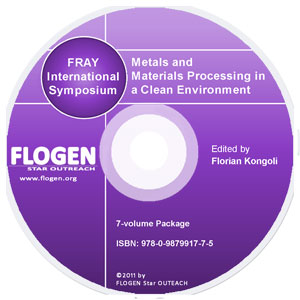
CD shopping page |
2011-Sustainable Industrial Processing Summit
|
| Editors: | Florian K |
| Publisher: | Flogen Star OUTREACH |
| Publication Year: | 2012 |
| Pages: | 646 pages |
| ISBN: | 978-0-9879917-6-8 |
| ISSN: | 2291-1227 (Metals and Materials Processing in a Clean Environment Series) |
Photoactive Calcium Phosphate Minerals For Hypersensitive Teeth
Esam Elmadani1; Animesh Jha1; SELECT * FROM contact WHERE email_address REGEXP('pmee@leeds.ac.uk|a.jha@leeds.ac.uk')*********************1UNIVERSITY OF LEEDS, Leeds, United Kingdom;
Type of Paper: Regular
Id Paper: 288
Topic: 9
Abstract:
Introduction: Teeth hypersensitivity is a common condition amongst large population worldwide. It is a lifestyle related condition, resulting from the progressive loss of mineral phase from enamel surface. Unlike bone, enamel cannot regenerate itself and, therefore, the softer underlying tissues dentin can be easily removed and modified by abrasion and acid erosion, respectively. Progressive erosion of enamel eventually exposes dentinal tubules to the external stimuli in the oral environment, causing movement of the fluid within these tubules stimulating the nerves in the pulp, which is the origin of pain. Treatments can be achieved by sealing the tubules using calcium hydroxide, laser and commercial brands of toothpaste such those containing hydroxyapatite, however, current treatments are neither permanent nor ubiquitous in terms of providing a solution for the dental condition as recurrence of sensitivity is commonly reported. Proposed novel concept: The project focuses on a novel concept of photo activation of calcium phosphate minerals, using both CW and pulsed laser for developing a clinical methodology for the treatment of sensitive teeth. In my PhD research, I am engineering photoactive calcium phosphate minerals, which can be applied in vitro onto hypersensitive mimicked teeth surfaces and then superficially sintered by controlled laser irradiations to form a new layer of minerals (hydroxyapatite) to completely occlude and seal dentinal tubules. The thermal load from a chosen laser is expected to induce phase transition and densify the new mineral phase over dentin surface with acid resistant material permanently, and therefore, preventing further erosion and subsequently hypersensitivity. Experimental work: Photoactive calcium phosphate powders were synthesized at room temperature by the chemical precipitation method, via the addition of Er2O3 and Tm2O3, while AlPO4 and CaF2 were added in attempt to improve the thermal stability and acid resistance. Undoped calcium phosphate powders were also prepared as control samples. Calcium phosphate particles/alcohol suspensions were prepared for in vitro teeth cross sections coating trials using clinically extracted human molar teeth, which were followed by laser irradiation trials. Pellets of calcium phosphate powders and treated teeth cross sections were characterized using scanning electron microscopy (SEM), X-Ray diffraction (XRD), thermogravimetric (TG) and micro-hardness analyses techniques. Results and conclusions: XRD patterns of undoped calcium phosphate show a pure monetite phase in good agreement with JCPDS card number 01-089-5969, while doped calcium phosphates show a modified monetite phase, possibly with shifted peaks as well as new peaks. XRD of AlPO4 doped calcium phosphate show peak intensities reduction and the emerging of new peaks as well as the presence of an amorphous phase compared to undoped calcium phosphate. On the other hand, Er2O3 - AlPO4 doped calcium phosphate show the modification of the major peaks in the monetite phase with a significant peak intensities increase and peak shifting. Changes in the monetite structure observed by XRD were confirmed by SEM, which show the change in the morphology of the monetite particles. The occlusion of dentin surfaces with all powders was satisfactory as the post laser irradiation should form new phase layer and seal the tubules as proposed. The addition of rare earth compounds seems to be a promising route for producing photoactive calcium phosphate minerals, which was demonstrated by the initial laser irradiation trials and resulted in a sintered area and morphology change of particles. AlPO4.Er2O3.CaF2 doped Calcium phosphate, shows a rosette particles growth and the occlusion of a large area of dentin surface. In addition, all doped calcium phosphates showed better thermal stability and increased harness of teeth sections.